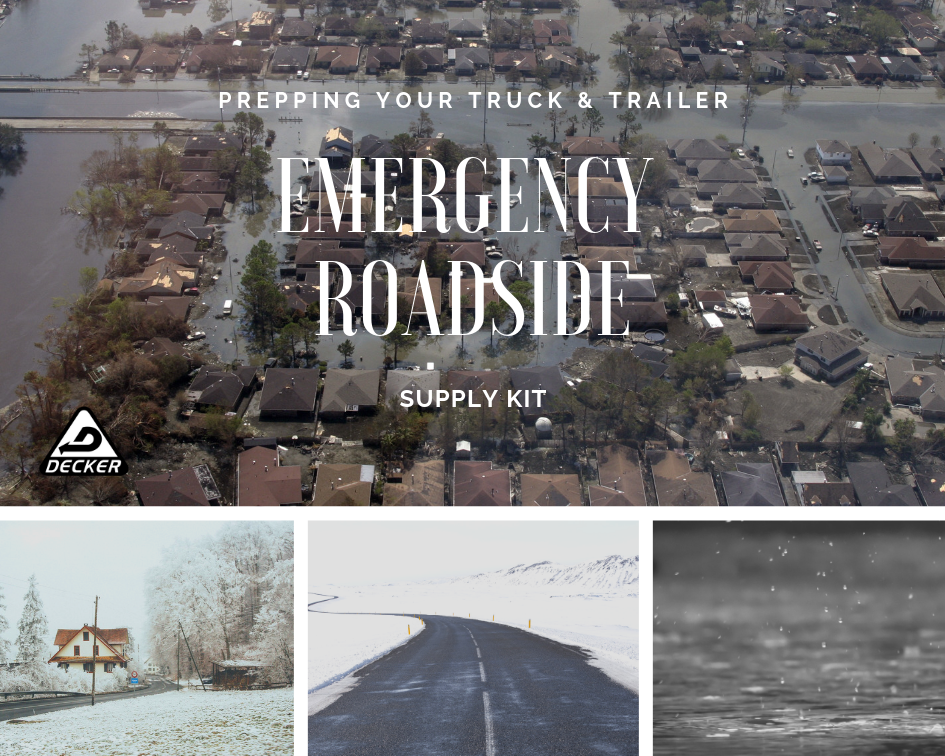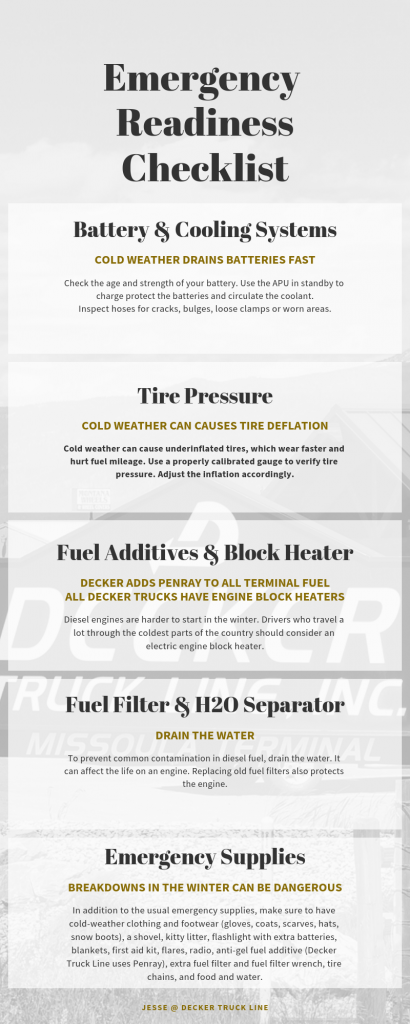Prepping Your Truck, Trailer and Emergency Roadside Kit for Winter 2018
Get Your Truck Ready For Winter 2018
Depending on where you live in the lower 48, fall weather can bring hurricanes, floods, snow, ice etc and if you are an over the road truck driver, you need to be prepared for them all.
Preparation starts BEFORE you are even out on the road. You know once September hits, you just never know what kind of weather will be around the corner. The best way to prepare yourself is to stay tuned into the weather forecasts, local stations and keep your equipment in check.
A proper pre-trip is not only in place to prevent DOT CSA violations and equipment breakdowns but most importantly to protect you and others on the road.

PRE-TRIP INSPECTION STEPS – Pre-Trip Vehicle Inspection Test from IA State Commercial Driver’s License Manual CDL Section 11 Vehicle Inspection Test
Top drivers always do a complete pre-trip inspections. It helps to prevent added unforeseen delays and improves safety but reducing the risk of out-of-control circumstances due to poor vehicle maintenance and wear and tear on the truck and trailer.
- Look over the entire unit thoroughly for body damage.
- Check fluid levels: oil and coolant levels.
- Look for oil, fuel, coolant, power steering fluid leaks
- Make sure caps are tight
- Observe at the engine block. Check for leaks, fluid running down the side of the engine.
- Look at the hoses. Check for wear, cracking or fraying.
- Inspect fan belts for proper tension and signs of wear.
- Take a look at the engine fan. Be sure they are not chipped.
- Look for any exposed or bare wires, or wires which appear out of place.
- Check windshield wiper fluid level.
- Inspect steering axle tires for uneven wear, nails, etc.
- Take a look at the shock absorbers, ball joints and kingpins for wear and proper lubrication.
- Check all tires on your tractor as well as the trailer. **Bob shared that you can get your tire pressure checked at Love’s for free if you have a Love’s card.
- Visually inspect the airlines and electrical cord, to ensure they are properly connected
- Visually check the 5th wheel to make sure it’s coupled to the trailer
- Ensure the landing gear is okay, legs are up and secure, and crank handle is secure
- Trailer suspension – air bags are up or no broken springs
- Brake pads. Look for good thickness. Minimum lining thickness is 1/4″ or below the wear indicator on the linings. (3/16″ for steer axle with continuous pad)
- Look for proper positioning for Brake indicators. Make sure no red marking is exposed.
- Observe gauges to be sure oil pressure is good and electrical system in charging
- Idle truck at 650 RPM, Do not high idle the truck right away.
- Glance at the gauges again to ensure all is okay and air pressure is building.
- Turn on all lights and flashers and exit the vehicle.
- Do a visual of the motor, looking for leaks
- Observe belts for proper tension and that they are turning properly
- Be certain all lights for proper function on truck and trailer.
- Listen for air leaks as you walk around the unit.
When I think of fall, I think of leaves. Keep your eyes open for piles on the road and be sure to slow down, avoid sudden braking or swerving. Piles can hide other debris which can be dangerous. Plus, if it recently rained, they can cause hydroplaning or get you spinning. So, be cautious in slippery conditions. A good rule of thumb is if the road looks wet and there is very little spray coming off your tires, you are more likely to be on black ice. This is more common when the temperature is between 22 to 35 degrees Fahrenheit.
The more water coming off your tires, the less likely the roads are icy, but clearly still wet. Be cautious.
If visibility becomes poor, slow down, turn/keep your lights on, put your hazards on and pull off the road. DO NOT pull onto the shoulder. As other drivers come up on your tail, they may think you are slowing down and still on the road. They WILL run into you. Get completely off the road into safety.
“In the winter, drive your truck based on your skills. Don’t try to keep up with another truck if it is not safe for you,” Nathan, veteran OTR driver and current DTL recruiter.
Know how to chain. Chain to get yourself out of trouble, not into trouble. Make sure you have chains on your trucks at all times, especially if you run in areas subject to inclement weather. North Western states have the chain law into effect as of Sept 1st.
Always check your chains for damage and do NOT go further on your chains than absolutely necessary. A Decker Truck Line lease purchase driver reminds us to “make sure your chains fit before the snow flies”. Don’t put yourself in the, “wish I would’ve” category.
The faster and further you drive on chains, the more likely damage to the chain or tires may occur. Do NOT drive on dry pavement with chains.
VISIBILITY

Your Windshield should be free of ice, snow, rain and cracks. Inspect your windshield wiper fluids and windshield wipers when you do your pre-trip so you are not adding on to possible visibility issues.
Vehicles that have slowed down because of visibility can be very dangerous. Be sure to give yourself enough room to pass. If you cannot see far enough to determine if you have enough room, you do NOT have enough room. The risk is not worth it.
Also, this time of year it’s more likely to see farm equipment on the road. They are slowing moving and can also create visibility barriers. Pass with caution.
Do not drive in groups. You may not be allowing yourself enough time to react. If the vehicle in front of you spins out and wrecks, the likelihood of you doing the same increases with the number of vehicles traveling together. Suggested: ¼ mile distance between you and other vehicles when traveling this season.
Put Your Emergency Roadside Kit Together

Days are getting shorter and nights are longer, no surprise that you may be driving in the dark more often this time of year. Plan accordingly. Safety 1st.
Additional helpful tips and suggestions from some of our Decker drivers:
“The best winter survival skill is prevention. A full truck stop is still better than a ditch.”
“when you stop for the night wait ten minutes and then pull forward. Cause your warm tires will make a groove in the snow and you’ll get stuck”
“Don’t pull your trailer break, they’ll freeze up when you wake up”
“Biggest thing…You’re not Superman slow down”
“And watch the road if there isn’t spray off the tires it’s frozen”
“if your pulling a pass don’t slow down going up just going down, keep your RPMs up”
Written By: Jesse Butler
Jesse Butler is a driver recruiter for Decker Truck Line. She has worked within the trucking industry for over a decade. You can contact her at 406.203.4413.
Apply directly to Decker Truck Line at www.DriveDecker.com


 Decker Podcast
Decker Podcast





